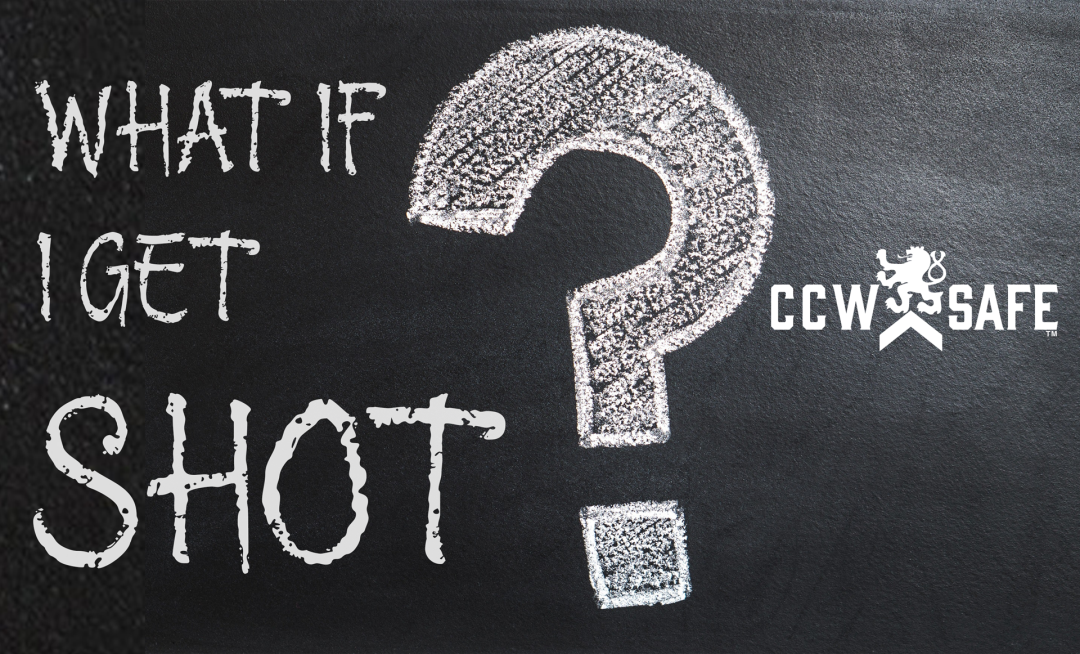
Posted on January 21, 2019
What If I Get Shot?
What If I Get Shot?
In the event that a lawful concealed carrier gets shot during an attempted robbery, carjacking, or similar event, the chances are good that it will be with a handgun. The damage that a low-velocity handgun bullet does to the human body is significantly less than that of a high-velocity rifle bullet. This is one of the reasons that SWAT team employ rifles when conducting high-risk entries. Hits to the upper thoracic area with a properly designed 5.56mm round have the ability to stop fights very quickly. Low-velocity pistol rounds, even with high-performance hollow point bullets, typically drill a permanent wound channel approximately the diameter of the expanded round. It would not be unreasonable to speculate that the approximate diameter might be somewhere between ½” and ¾”. If the handgun round used meets the FBI’s protocol, penetration might be somewhere around 12”.
I attended a course entitled Tactical Medicine for the Operator hosted by Dallas SWAT some years ago. During the course, a Naval Battalion Surgeon said the following: “There are gunshot wounds that will kill you regardless of the available medical care, there are gunshot wounds that will not kill you even without medical care, and finally there are gunshot wounds that will kill you without medical care.” This article will address gunshot wounds that without treatment might end lives.
Caleb Causey of Lone Star Medics (www.lonestarmedics.com) is a former army combat medic who has approximately 20 years of experience in field and tactical medicine. His background includes time spent as a volunteer firefighter/EMT and SWAT team tactical medic. He is a highly-regarded trainer and regular presenter at the annual Rangemaster Tactical Conference. In 2017, Caleb taught tactical medicine classes in 15 different states. I recently approached Caleb and sought his opinion as to what gunshot wounds (or other penetrating wounds, including those caused by knives and other cutting instruments) should the concealed carrier be knowledgeable of, and what is the best way to address those given the fact that most of us are unable or unwilling to walk around with a complete emergency first aid kit.
Circulation, Airway, and Breathing should be addressed in that order. A person can survive for several minutes without oxygen, but once blood leaves the human body it can’t be put back in. Without immediate treatment, blood loss resulting from damage to any of the various arteries in the human body is life-threatening. Persons shot in the arms and legs can quickly perish. Gunshot or other penetrating wounds to the torso that strike a lung can cause a pneumothorax (sucking chest wound) or tension pneumothorax (air escapes the lung but remains inside the chest cavity). The concealed carrier should be able to control arterial bleeding from the limbs through the use of a proper tourniquet if possible, and have the means to pack the wound with QuickClot gauze if the wound is located so high on the leg or arm that use of a tourniquet is not possible. A proper chest seal can be applied to a pneumothorax in order to buy precious time before medical attention can be obtained.
Caleb recommends that the concealed carrier should have on their person when outside the home the following items:
- QuickClot Gauze
- CAT tourniquet or Soft-T Wide tourniquet
- Beacon Chest Seal or Russell Chest Seal
- Benchmade 7 Rescue Hook Cutter
Caleb rightfully points out that this is just barely enough equipment to cover the needs of only one person, and insufficient perhaps to address multiple wounds suffered by the concealed carrier. It is definitely inadequate if the concealed carrier is in the company of other family members or friends. He also recommends that concealed carriers maintain a bag capable of treating every member of their family in both their vehicle and home.
In order to be able to use the tools described above immediately after a high-stress incident, nothing beats prior training. Stopping to read the instructions seconds after a gunfight is not recommended. Caleb regularly teaches 8-hour basics field and tactical medicine classes, and after training under Caleb myself I can certainly vouch for him. There are various other trainers out there that are capable of doing similar instruction.
The concealed carrier should not be lulled into thinking that preparing for this particular part of a deadly force incident can be put off just because one believes that his or her chances that they will be involved in a deadly force encounter are small. More people are killed or badly injured in car wrecks than they are in gunfights or stabbed. Some injuries sustained in car wrecks have much in common with injuries sustained during a violent criminal assault. The concealed carrier would be best served being prepared for either.
 |
Steve MosesSteve is a long-time defensive weapons and instructor based out of Texas who has trained hundreds of men and women of all ages for more than two decades on how to better prepare to defend themselves and their loved ones. Steve has completed over 80 private-sector and law enforcement-only defensive weapons and tactics classes, and has trained civilian and law-enforcement officers in six states. Moses is a reserve deputy, former member of a multi-precinct Special Response Team, competitive shooter, and martial artist. Steve has written numerous articles for SWAT Magazine and other publications. Steve is a licensed Texas Level 4 Personal Security Officer and Instructor who was Shift Lead on a mega-church security detail for seven years, and has provided close protection for several former foreign Heads of State. He is currently an instructor at Relson Gracie Jiu Jitsu/Krav Maga in Tyler, Texas and Director of Training for Palisade Training Group (www.ptgtrainingllc.com). |